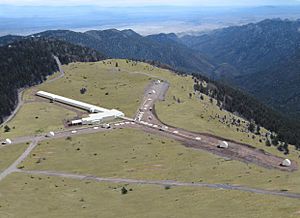Magdalena Ridge Observatory facts for kids
| Location | Socorro County, New Mexico, US |
|---|
The Magdalena Ridge Observatory (MRO) is a special place in Socorro County, New Mexico, USA, where scientists study space! It's about 32 kilometers (20 miles) west of the town of Socorro. This observatory is high up in the Magdalena Mountains, close to the top of South Baldy Mountain.
Since 2008, MRO has been using a 2.4-meter optical telescope that can track objects very quickly. They are also building a huge ten-element optical interferometer there.
The MRO Interferometer project is a team effort between the New Mexico Institute of Mining and Technology (New Mexico Tech) and the Cavendish Astrophysics Group from the University of Cambridge. The main funding for this project comes from the United States Naval Research Laboratory (NRL).
Contents
Amazing Telescopes at MRO
The 2.4-meter Telescope
The MRO 2.4-meter (about 8-foot) telescope is designed to move very fast. It can turn 10 degrees every second! This speed allows it to watch objects like satellites orbiting close to Earth.
Scientists also use this telescope to study asteroids and other objects in our Solar System. The telescope first saw light on October 31, 2006. It started working regularly on September 1, 2008. One of its first big tasks was tracking a near-Earth asteroid called 2007 WD5 for NASA.
The main mirror of this telescope has an interesting story. It was made by a company called Itek. It was part of a competition to build the mirror for the famous Hubble Space Telescope. Another company, Perkin-Elmer, won that job. So, this mirror went to a secret Air Force project. When that project ended, the mirror was given to the Magdalena Ridge Observatory.
Since May 2008, the MRO telescope has been working with NASA. It helps track and learn about near-Earth asteroids and comets as part of a program called Spaceguard. It also works with the Air Force to track and understand satellites in different orbits.
On October 9, 2009, scientists used the MRO 2.4-meter telescope to watch something amazing. They observed two NASA Centaur rockets crash into the Moon's south pole. This was part of the LCROSS Project, which helped us learn more about the Moon.
In 2015, it was announced that the MRO telescope would get funding from the FAA. This money helps it monitor rockets and spacecraft launching from Spaceport America. It also watches them as they return to Earth.
Magdalena Ridge Optical Interferometer (MROI)
The Magdalena Ridge Optical Interferometer (MROI) is a special kind of optical and near infrared interferometer. It is currently being built at MRO. When it's finished, it will have ten telescopes, each about 1.4 meters (55 inches) wide. These telescopes will be placed along three long arms, each about 340 meters (1,115 feet) long.
Each arm will have nine spots where the telescopes can sit. One telescope can also be placed right in the center. A special crane will move the telescopes and their covers. Light from the telescopes' main mirrors will travel through long pipes to a building called the Beam Combining Facility (BCF). These pipes will have all the air removed to prevent any distortions to the light.
Inside the BCF, the light will first go through special "delay lines." These lines make sure all the light beams arrive at the same time, or "in phase." Then, the light leaves the vacuum pipes. It goes into the Beam Combining Area, where it is sent to one of three main sensors. It can also go to a temporary instrument. The light will hit eleven mirrors in total before it reaches a sensor!
The MROI is being built to help scientists study three main things:
- How stars and planets form.
- How stars grow by collecting material (called stellar accretion) and how they lose material (called mass loss).
- What happens in the very bright centers of some galaxies, known as active galactic nuclei.
An interferometer was chosen for this work because it can see much finer details than a single telescope. This means it can create clearer images of distant objects. However, interferometers don't gather more light than a single large telescope. The total area of their mirrors is usually quite small.
MROI Construction Progress
The basic plan for MROI was finished in 2006. Building the facility started in August 2006 with the BCF building, which was completed in 2008. In 2007, a company from Belgium called AMOS was chosen to design the ten 1.4-meter telescopes.
By 2009, the designs for the interferometer arms and the telescope covers were ready. In 2010, construction of the arms began. Also in 2010, the first delay line was put into the BCF.
On October 19, 2015, New Mexico Tech signed an agreement with the Air Force Research Laboratory. This agreement provides $25 million over five years to keep building the interferometer. Dr. Van Romero, a leader at New Mexico Tech, said this new money will help them finish three telescopes, their mounts, and their enclosures.
New Mexico Exoplanet Spectroscopic Survey Instrument (NESSI)
The New Mexico Exoplanet Spectroscopic Survey Instrument (NESSI) is a special tool built to study the atmospheres of exoplanets. Exoplanets are planets that orbit stars outside our own solar system.
This instrument cost $3.5 million. It is the first tool made specifically for looking at exoplanet atmospheres. Scientists expect it to greatly help us understand these distant worlds.
The main scientist leading the NESSI project is Michele Creech-Eakman from the New Mexico Institute of Mining and Technology. She works with seven other scientists. The NESSI instrument was placed on the observatory's 2.4-meter telescope. It started observing exoplanets in April 2014.
See also
 In Spanish: Observatorio Magdalena Ridge para niños
In Spanish: Observatorio Magdalena Ridge para niños


